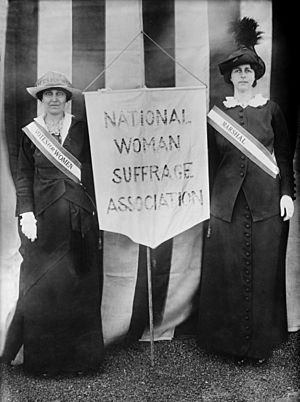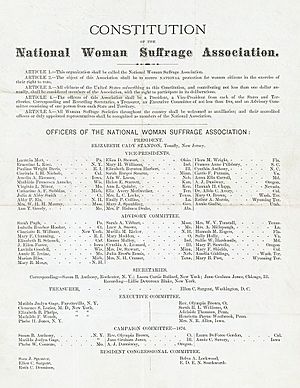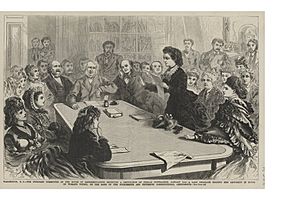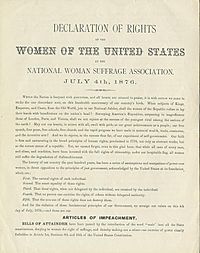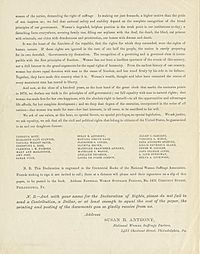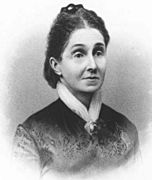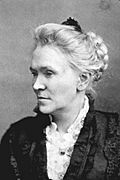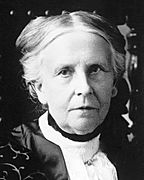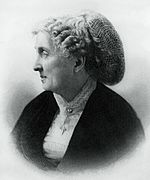National Woman Suffrage Association facts for kids
The National Woman Suffrage Association (NWSA) was an important group formed on May 15, 1869. Its main goal was to help women get the right to vote in the United States. The most well-known leaders of the NWSA were Susan B. Anthony and Elizabeth Cady Stanton.
This group was created after the women's rights movement had a disagreement. This disagreement was about a new law called the Fifteenth Amendment to the U.S. Constitution. This amendment would give voting rights to black men. Some people in the movement supported this law. But others, who later formed the NWSA, did not. They believed that women and all African Americans should get the right to vote at the same time.
The NWSA focused mostly on changing federal laws to get women the right to vote. In the early 1870s, they encouraged women to try voting. If they were stopped, the NWSA told them to file lawsuits. They argued that the Constitution already gave women the right to vote through its promise of equal protection for all citizens. Many women tried to vote, including Susan B. Anthony. She was arrested and found guilty in a very public trial. After the Supreme Court said the Constitution did not automatically give women the right to vote, the NWSA worked for a new amendment that would clearly state this right.
The NWSA and its leaders also worked on other projects. They wrote a history of the women's suffrage movement. They also helped create the International Council of Women, which is still active today. The disagreement in the suffrage movement ended in 1890. The NWSA joined with another group, the American Woman Suffrage Association (AWSA). They formed the National American Woman Suffrage Association (NAWSA), with Anthony and Stanton as leaders.
Contents
- Why the NWSA Was Formed
- Forming the National Woman Suffrage Association
- NWSA vs. AWSA
- Early Activities
- The New Departure Idea
- Fighting for Voting Rights
- 100th Anniversary of the Declaration of Independence
- Writing the History of Woman Suffrage
- International Council of Women
- The Movement Comes Together
- Some Other Important Members
- See also
Why the NWSA Was Formed
Women's suffrage became a big topic in the mid-1800s. A key event was the first women's rights meeting, the Seneca Falls Convention in 1848. Elizabeth Cady Stanton helped start this meeting. At first, the idea of women voting was very new and even controversial among women. But soon after the convention, it became a central goal of the movement.
In 1851, Stanton and Susan B. Anthony started a partnership that lasted for decades. This partnership was very important for women's rights and for the future NWSA. For many years, they worked together to end slavery and to gain rights for women.
In 1866, Anthony and Stanton organized the Eleventh National Women's Rights Convention. This was the first such meeting since the Civil War began. At this convention, members decided to create the American Equal Rights Association (AERA). This group aimed to fight for equal rights for all citizens, especially the right to vote. Its members were mostly activists from the women's rights and anti-slavery movements. Important leaders included Lucretia Mott, Lucy Stone, and Frederick Douglass.
Disagreement Over Voting Rights
Over time, AERA members who cared most about women's right to vote started to have different ideas. One group, led by Lucy Stone, was okay with black men getting the right to vote first. They wanted to stay close to the Republican Party. The other group, led by Stanton and Anthony, wanted women and black men to get the right to vote at the same time. They wanted the women's movement to be independent and not rely on anti-slavery groups for money.
In 1868, Anthony and Stanton started publishing The Revolution. This was a weekly newspaper about women's rights in New York City. It became an important way for their group to share its ideas.
The disagreement grew stronger when the Fifteenth Amendment was introduced. This amendment would give black men the right to vote by saying that race could not stop someone from voting. Lucy Stone supported this amendment. Stanton and Anthony were against it. They insisted that all women and all African Americans should get the right to vote at the same time. Stanton argued that if only men could vote, it would make it seem like men were better than women.
Forming the National Woman Suffrage Association
The AERA group broke apart after a difficult meeting in 1869. After this, two new women's suffrage groups were formed. The National Woman Suffrage Association (NWSA) was created on May 15, 1869. This was two days after the AERA's last meeting. Anthony and Stanton were its main leaders. The American Woman Suffrage Association (AWSA) was formed in November 1869, with Lucy Stone as its main leader.
Some of the NWSA's members came from other groups that Anthony and Stanton had started. One of these was the Women's Loyal National League. By 1864, its 5,000 members had gathered many signatures for a petition to end slavery. This was the largest petition drive in the nation's history. Another group was the Working Women's Association. This group started with women who earned wages but later included mostly middle-class working women like journalists and doctors. Its members formed the main part of the NWSA in New York City, where the NWSA had its headquarters.
NWSA vs. AWSA
Even after the Fifteenth Amendment was passed in 1870, there were still important differences between the two groups.
The NWSA mainly worked at the federal level, trying to get a constitutional amendment for women's suffrage. The AWSA worked more at the state level for the same goal. NWSA meetings were open to everyone. But the AWSA only allowed representatives from state groups to vote at its meetings, though any member could attend and speak.
The NWSA first dealt with several women's issues, like divorce reform and equal pay for women. The AWSA focused almost only on suffrage. The AWSA had both women and men as members. Its first president was a man, Henry Ward Beecher. Stanton had wanted the NWSA to only have women members, but this idea was not accepted. However, most NWSA members and leaders were women. The NWSA held its meetings in Washington, D.C., because it focused on federal laws. The AWSA met in different cities across the country, as it worked more at the state level.
Some African American women joined both groups. A study shows nine black women were in the AWSA in the 1870s and six in the NWSA. While the NWSA did not stop Black women from joining at the national level, local NWSA groups could choose to not include them.
Early Activities
Many people who supported women's right to vote were upset by the split and wanted the groups to reunite. Theodore Tilton, a newspaper editor, tried to bring them together. In April 1870, he held a meeting with members from both groups. Anthony and Lucy Stone were against merging. The NWSA sent three representatives who said their group would only merge if the new group agreed to work for a Sixteenth Amendment to give women the right to vote. Lucy Stone and two other AWSA members left the meeting at that point.
Those who stayed formed a new group called the Union Woman Suffrage Association (UWSA). Tilton became its president, and its main goal was the Sixteenth Amendment. Soon after, the AERA group voted to join the UWSA. The next month, the NWSA itself joined the UWSA, which basically became the NWSA under a new name.
In May 1870, Anthony had to sell The Revolution newspaper because of money problems. This meant the NWSA lost its main way to share news. After this, the NWSA used smaller newspapers like The National Citizen and Ballot Box, edited by Matilda Joslyn Gage, and The Woman's Tribune, edited by Clara Bewick Colby, to share its views.
The NWSA grew stronger because Stanton and Anthony traveled a lot to give speeches. They brought new members into the group at local, state, and national levels. They traveled more than any other reformer or politician of their time. From 1869 to 1879, Stanton traveled eight months a year, often giving one speech a day. In one year, Anthony traveled 13,000 miles and gave at least 170 speeches.
The NWSA did not have a main office. Its mailing address was just one of its officers' addresses. Anthony and Stanton did not get paid by the group. They supported themselves with money from their speeches. Anthony even used her speech money to help pay off the newspaper's debts and fund the organization.
The New Departure Idea
In 1869, Virginia Minor, an NWSA member, and her husband Francis had an idea called the New Departure. They believed that women already had the right to vote because of the U.S. Constitution. Their idea was based on the Fourteenth Amendment. This amendment says that no state can take away the rights of citizens or deny anyone equal protection under the law.
In January 1871, the UWSA delayed its annual meeting so members could hear Victoria Woodhull speak. She was the first woman to speak before a group in Congress. She was a stockbroker with rich supporters but was new to the women's movement. She presented a different version of the New Departure idea. Instead of asking courts to say the Constitution gave women the right to vote, she asked Congress to pass a law that would declare it. Congress did not accept her idea. Woodhull was invited to give the same speech at the UWSA's meeting and was met with excitement.
Woodhull's fame as a women's suffrage leader grew. Stanton and Anthony supported her at first, but Anthony became more careful around her. At the UWSA's 1872 meeting, Woodhull tried to take over the group. She told members to meet the next day in a different place to form a new political party with her as a candidate for president. In the confusion, Anthony quickly ended the meeting and said the UWSA would meet as usual the next day. The UWSA did meet, but with fewer people, as many had gone to Woodhull's event. At this meeting, the UWSA voted to become the NWSA again, with Anthony as president.
Later that year, Woodhull shared details of a private matter between Elizabeth Tilton, the wife of Theodore Tilton (an NWSA supporter), and Reverend Henry Ward Beecher (the first president of the AWSA). This greatly harmed the reputation of the entire women's movement. After this, Woodhull was no longer a major part of the women's suffrage movement.
In 1871, the NWSA officially adopted the New Departure strategy. They encouraged women to try to vote and to sue if they were stopped. Hundreds of women tried to vote in many places.
Fighting for Voting Rights
In 1872, Susan B. Anthony convinced some election officials to let her vote in the presidential elections. She was arrested for this and found guilty in a very public trial. The judge was Justice Ward Hunt, who was a Supreme Court Justice.
The trial, United States v. Susan B. Anthony, was watched closely by newspapers across the country. At that time, people accused of crimes in federal courts could not speak in their own defense. So, Justice Hunt did not let Anthony speak until the decision was given. At the end of the trial, Justice Hunt read his decision and told the jury to find her guilty.
When he asked Anthony if she had anything to say, she gave what a historian called "the most famous speech in the history of the agitation for woman suffrage." She kept talking even when the judge told her to stop. She criticized him for not letting her have a jury trial. She also said that even if she had a jury, it wouldn't be fair because women were not allowed to be jurors.
In 1875, the Supreme Court ruled in Minor v. Happersett that "the Constitution of the United States does not confer the right of suffrage upon anyone." This meant the Constitution did not automatically give anyone the right to vote. Because of this, the NWSA had to go back to the harder plan of getting a constitutional amendment. In 1878, Senator Aaron A. Sargent, whose wife Ellen Clark Sargent was the NWSA treasurer, introduced a women's suffrage amendment in Congress. More than forty years later, this would become the Nineteenth Amendment. Its words are almost the same as the Fifteenth Amendment, but it stops states from denying the right to vote because of sex, not race.
100th Anniversary of the Declaration of Independence
On July 4, 1876, the United States celebrated its 100th birthday in Philadelphia at Independence Hall. This is where the Declaration of Independence was approved in 1776. The NWSA set up its headquarters nearby. They started writing "articles of impeachment" against the country's male leaders. NWSA officers asked if they could present a Declaration of Rights for Women at the official celebration, but they were told no.
Despite being refused, five women, led by Anthony, walked onto the stage during the ceremony. They handed their Declaration to Senator Thomas Ferry, who was in charge of the celebration. As they left, they gave copies to the crowd. Anthony then stood on an empty bandstand outside the hall and read the Declaration to many people. She invited everyone to an NWSA meeting at a nearby church to hear Stanton, Lucretia Mott, and other speakers.
The Declaration was signed by Susan B. Anthony and other important NWSA members. These included Lucretia Mott, Elizabeth Cady Stanton, Paulina Wright Davis, Ernestine L. Rose, Clarina I. H. Nichols, Mary Ann McClintock, Amy Post, Sarah Pugh, Matilda Joslyn Gage, Clemence Sophia Harned Lozier, Olympia Brown, Mathilde Franziska Anneke, Mathilde F. Wendt, Adelaide Thomson, Laura de Force Gordon, Ellen Clark Sargent, Virginia L. Minor, Sara Andrews Spencer, Lillie Devereux Blake, Phoebe Couzins, Jane Graham Jones, Abigail Scott Duniway, and Belva A. Lockwood.
Lucretia Mott, a former president of the AERA, was listed first among the signers. She was also a vice president of the NWSA. She tried to stay neutral in the split within the women's movement, supporting both sides.
Writing the History of Woman Suffrage
In 1876, Anthony and Stanton started working on the History of Woman Suffrage. They first thought it would be a small book. But it grew into a six-volume work with over 5,700 pages. It took 41 years to write. This project saved a lot of important history that might have been lost.
Anthony and Stanton mainly wrote the first three volumes, which cover the movement up to 1885. Anthony managed the publishing details, while Stanton wrote most of the text. Matilda Joslyn Gage, another important NWSA member, wrote three chapters of the first volume. She had to stop because her husband became ill. After Stanton died, Anthony published Volume 4 with help from Ida Husted Harper. After Anthony's death, Harper finished the last two volumes, bringing the history up to 1920.
Stanton and Anthony asked their rival Lucy Stone to help with the book. They wanted her to send materials about her part of the movement. But she refused to help. Stanton's daughter, Harriot Stanton Blatch, wrote a 120-page chapter about Stone and the AWSA, which is in Volume 2. Even so, the History of Woman Suffrage focuses mostly on Stanton, Anthony, and the NWSA. It gives less attention to Stone and the AWSA.
International Council of Women
Anthony traveled to Europe in 1883 and met Stanton, who had arrived a few months earlier. For nine months, they met with leaders of women's movements in different European countries. They began to plan for an international women's organization.
The NWSA agreed to host the first meeting of this new group. The first meeting of the International Council of Women (ICW) took place in Washington in 1888. It had representatives from 53 women's organizations in nine countries. These groups included suffrage associations, professional groups, literary clubs, and more. The AWSA also took part in this meeting. The ICW convention helped the women's movement gain more public attention and respect. President Grover Cleveland even invited the representatives to a reception at the White House. The ICW is still active today and works with the United Nations.
The Movement Comes Together
Lucy Stone started the idea of reuniting the two rival suffrage groups. She was 70 years old and not in good health. The AWSA was also losing strength. Anthony, on the other hand, was a very important political figure in the United States by then. Stanton was also well-known as a popular speaker and writer.
In November 1877, the AWSA's annual meeting passed a resolution. It allowed Stone to talk with Anthony about a possible merger. This idea did not cause much debate within the AWSA. However, there was strong opposition within the NWSA. Ida Husted Harper, Anthony's co-worker and biographer, said the NWSA meetings about this issue were "the most stormy in the history of the association." Matilda Joslyn Gage, who was against the merger, formed a new group called the Woman's National Liberal Union. But it did not attract many followers, and the plans for the merger continued.
The NWSA and the AWSA held a joint meeting in Washington. They formed the National American Woman Suffrage Association (NAWSA) on February 18, 1890. Anthony insisted that Stanton accept the presidency. This was mostly a symbolic role. The day after she was elected, Stanton sailed to England and stayed there for 18 months, leaving Anthony in charge. Stone was elected chair of the executive committee.
The NAWSA became the largest volunteer organization in the nation, with two million members. After women gained the right to vote in 1920 with the Nineteenth Amendment, the NAWSA changed its name to the League of Women Voters, which is still active today.
Some Other Important Members
-
Virginia Minor, who helped create the NWSA's New Departure idea.
-
Ernestine Rose, a pioneer for women's rights and a member of the first NWSA executive committee.
-
Matilda Joslyn Gage, NWSA president from 1875–86, co-author of History of Woman Suffrage.
-
Olympia Brown, the first woman to be ordained as a minister with her church's approval.
-
Paulina Kellogg Wright Davis, a main organizer of the first National Women's Rights Convention.
See also
 In Spanish: Asociación Nacional pro Sufragio de la Mujer para niños
In Spanish: Asociación Nacional pro Sufragio de la Mujer para niños
- List of suffragists and suffragettes
- List of women's rights activists
- Timeline of women's suffrage
- Timeline of women's suffrage in the United States
- Women's suffrage organizations


